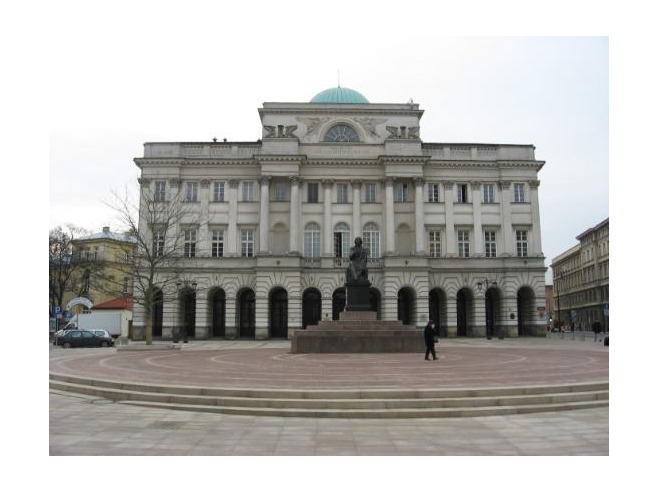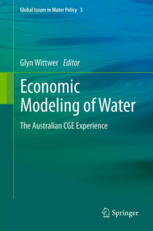
Course Venue: Palace of Staszic -- see previous course photos here.
This one-week intensive course introduces participants to the equations and data structure of a dynamic version of TERM -- a multiregional CGE model of a single country -- and provides them with extensive hands-on experience with the GEMPACK and RunDynam software used to solve CGE models.
For 2013 the course was presented during 2-7 September in the centre of Warsaw. Outside of course hours, activities were scheduled for participants to enjoy Warsaw's rich offerings of museums, theatres, exhibitions and restaurants. You can download a course brochure here, which contains further details, and contact points for enquiries.

Course Venue: Palace of Staszic -- see previous course photos here.
TERM (The Enormous Regional Model) is a multiregional CGE model of a single country, which is "bottom-up" -- it treats each region as a separate economy. Two key features of TERM are: (a) its ability to solve quickly with a large number of regions or sectors, and (b) its database construction methodology, which allows a multiregional database to be constructed quickly, even with quite limited regional data. Dynamic TERM is a recursive-dynamic version that allows the effects of economic shocks to be tracked over time.
Recent Australian versions of TERM have distinguished up to 172 sectors and 206 regions, so that urban areas, water catchment areas and tourism regions may all be distinguished accurately. The high degree of regional detail makes TERM a useful tool for examining the regional impacts of shocks (especially supply-side shocks) that may be region-specific. Finally, TERM has a particularly detailed treatment of transport costs and is naturally suited to simulating the effects of improving particular road or rail links.
Versions of TERM have been prepared for Brazil, Finland, China, Indonesia, South Africa, Poland, USA and Japan. The course material is mainly based on the Indonesian version but would apply with small modification to other versions of TERM.
Read more about the TERM model.
The course runs from Monday 9am to Saturday 1.15pm. During the first 3.5 days, about equal time is spent on lectures, explaining CGE theory as applied to TERM, and on lab sessions designed to teach how to compute and explain simulation results. Then, participants form into groups, each focused on running and analysing different simulations. On Friday afternoon the groups present and explain their simulation results.
The course should appeal to those needing background in CGE modelling in order to work with, or understand results from a typical multi-regional CGE model, and to those wishing to learn dynamic CGE modelling using GEMPACK and RunDynam.
Download the detailed provisional Course Program.
Course participants receive a folder, containing
At the end of the course participants receive one or more CD/DVDs, containing
Each participant also receives a copy of this  Book published by Springer: "Economic Modeling of Water: The Australian CGE
Experience", Edited by Glyn Wittwer.
Book published by Springer: "Economic Modeling of Water: The Australian CGE
Experience", Edited by Glyn Wittwer.
The book focuses on the application on a specially-adapted dynamic version of TERM, TERMH2O to model Australian drought
problems and water-management policies.
As with our introductory Practical GE Modelling Course, previous hands-on experience in solving GE models is not essential. Again we require that course participants have:
Nevertheless the multi-region, multi-period model presented in this course is more technically demanding than the single-region, comparative static model used in the Practical GE Modelling course, and we expect that many participants will have previous exposure to CGE modelling.
If you have not worked with GEMPACK before, you should definitely download and work through the MINIMAL course material. Although far simpler, the MINIMAL model and course use similar notation and software to TERM. To go further, you could:
Please note that participants need to bring their own laptops and install GEMPACK before the course.
Course fees cover: course materials (including software), lunches, morning and afternoon teas. They do not cover accommodation, transportation, breakfast or evening meals. The fees, and payment methods, are listed at the end of the course brochure .
Participants are required to arrange their own accommodation -- there are many nearby accommodation options.
Katarzyna Drozdziel, Project Officer
Prof. nadzw. dr hab. Katarzyna Zawalinska, Deputy Director
IRWiR Polish Academy of Sciences
Nowy Swiat Str. 72, 00-330 Warsaw, Poland
Tel.: +48 22 6572 915, +48 22 6572 772
http://www.irwirpan.waw.pl http://www.irwirpan.waw.pl